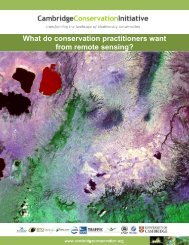CONSERVING BIODIVERSITY & DELIVERING ECOSYSTEM SERVICES
conserving biodiversity & delivering ecosystem services
conserving biodiversity & delivering ecosystem services
Create successful ePaper yourself
Turn your PDF publications into a flip-book with our unique Google optimized e-Paper software.
It has been estimated that Nepal stores 485 million metric tonnes of carbon (in living biomass,<br />
FAO 2006), equivalent to almost 50% of the EU’s greenhouse gas emissions in 2009, thereby<br />
contributing to global climate change regulation. There are now on-line tools that can<br />
illustrate this spatially, showing that not all areas are equally important for all services, with<br />
carbon storage in the Terai and High Himalaya (where fewer trees occur) being relatively low<br />
compared to that of the Siwalik, Middle and High Mountains.<br />
Biomass carbon stored in above<br />
and below-ground living<br />
vegetation<br />
SOURCE Ruesch and Gibbs (2008) IPCC<br />
Tier-1 global biomass carbon map for<br />
2000. Available online from the Carbon<br />
Dioxide Information Analysis Center http:/<br />
/cdiac.ornl.gov.<br />
Similarly, it is possible to illustrate water flows spatially, showing that some areas, such as the<br />
central region of Nepal, are very important for providing water to surrounding areas (including<br />
the Kathmandu Valley.<br />
Per capita water availability<br />
according to regional<br />
administrative boundaries<br />
Where water balance is shown as<br />
negative, water use is supported by<br />
upstream sources and/or groundwater<br />
SOURCE Waterworld version 2.3 (2012).<br />
Available on-line from http://<br />
www.policysupport.org/waterworld.<br />
As well as general analyses, there have been a number of more specific projects in Nepal that<br />
deal with ecosystem services. Some relate to opportunities for developing or piloting Payment<br />
for Ecosystem Service schemes (PES, see p.9), such as carbon credit projects taking advantage<br />
of emerging markets for forest carbon (e.g. by the Asia Network for Sustainable Agriculture<br />
and Bioresources, ANSAB). Others relate specifically to mountain habitats (e.g. by the<br />
International Centre for Integrated Mountain Development, ICIMOD) or wetlands (e.g. by the<br />
Conservation and Sustainable Use of Wetlands in Nepal project, CSUWN).




